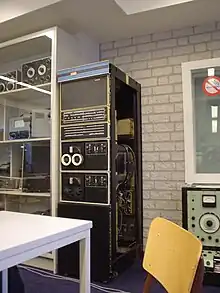Institute of Sonology
The Institute of Sonology is an education and research center for electronic and computer music based at the Royal Conservatoire of The Hague in the Netherlands.
Background
The institute was founded at Utrecht University in 1960 as the Studio for Electronic Music (STEM), as a successor to the former studio for electronic music at Philips' NatLab in Eindhoven. In 1964, Gottfried Michael Koenig became the studio's artistic director. The studio grew under Koenig's leadership, and in 1966 an annual international electronic music course was founded which exists to this day.[1]
In 1967 STEM was renamed as the "Institute of Sonology". International attention increased in 1971 with the purchase of a PDP-15 minicomputer which was used to develop programs for algorithmic composition and digital sound synthesis.[2] During the early years of the institute, a series of landmark programs were developed there, including Koenig's Project 1, Project 2,[3] and SSP,[4] Paul Berg's PILE,[5] Werner Kaegi's MIDIM/VOSIM,[6] and Barry Truax's POD.[7] In 1971 the Brazilian composer Jorge Antunes, a precursor of electronic music in his country, was a student at the Institute where he composed the work "Para Nascer Aqui".
In 1986, the institute was moved to the Royal Conservatory of The Hague, hosting the International Computer Music Conference there during its inaugural year.[8]
Current research focuses on algorithmic composition, live electronic music, historical reconstructions of electronic and computer music (including György Ligeti's Pièce électronique Nr. 3 and Edgard Varèse's Poème électronique), field recording, sound installations, and sound spatialization.[9] Alongside the annual one-year course, the institute offers bachelor's and master's degrees in Sonology.

Discography
- Gottfried Michael Koenig – The Electronic Works (1990) BV Haast
- His Master's Noise (2001) BV Haast
- Kees Tazelaar – Electronic compositions (2004) Near
- Institute of Sonology: Early Electronic Music 1959–1969 (2009) Sub Rosa
- Anthology of Dutch Electronic Tape Music, vols. 1 and 2 (1979) Composer's Voice[10]
Notable teachers and alumni
- Ángel Arranz
- Clarence Barlow
- Jorge Antunes
- Richard Barrett
- Justin Bennett
- Paul Berg
- Konrad Boehmer
- Darien Brito
- Nuno Canavarro
- Luc Döbereiner
- Cathy van Eck
- Barbara Ellison
- Angel Faraldo
- Raviv Ganchrow
- Kathrin Grenzdörfer
- Marie Guilleray
- Bjarni Gunnnarsson
- Edwin van der Heide
- Werner Kaegi
- Ji Youn Kang
- Roland Kayn
- Gottfried Michael Koenig
- Fani Konstantinidou
- Johan van Kreij
- Otto Laske
- Giacomo Lepri
- Cort Lippe
- Igor Lintz Maués
- Sergio Luque
- Riccardo Marogna
- Fred Momotenko
- Hugo Morales Murguia
- Yota Morimoto
- Lasse Nøsted
- Peter Pabon
- Gabriel Paiuk
- Jean Piché
- Sara Pinheiro
- Kees van Prooijen
- Dick Raaijmakers (also taught at the Royal Conservatoire's pre-Sonology studio)
- Takayuki Rai
- Joel Ryan
- Robert Rowe
- Wouter Snoei
- Peter Struycken
- Kees Tazelaar
- Stan Tempelaars
- Roland Kuit
- Barry Truax
- Henry Vega
- Claude Vivier
- Rodney Waschka II
- Frits Weiland
- Anne Wellmer
- Amnon Wolman
- Semay Wu
- Andrea Young
References
- Institute of Sonology (2010), "1964–1986 STEM" Archived 2011-07-20 at the Wayback Machine Retrieved 2011-02-06
- Tempelaars, S. and Koenig, G. M. (1972), "The computer at the institute of sonology, Utrecht", Journal of New Music Research, 1 (2): 167–174
- Koenig, G. M. and Roads, C. (1978), "An Interview with Gottfried Michael Koenig", Computer Music Journal, 2 (3): 11–15, 29
- Berg, P.; Rowe, R. and Theriault, D. (1980), "SSP and Sound Description", Computer Music Journal, 4 (1): 25–35
- Berg, P. (1979), "PILE: A Language for Sound Synthesis", Computer Music Journal, 3 (1): 30–41
- Kaegi, W. (1978), 'VOSIM-A New Sound Synthesis System', Journal of the Audio Engineering Society, 26 (6):418–425
- Truax, B. (1977), "The POD System of Interactive Composition Programs", Computer Music Journal, 1 (3): 30–39
- Sani, N. and Bernardini, N. (1987), "1986 International Computer Music Conference, Den Haag: Review in Two Parts", Perspectives of New Music, 25 (1/2): 618–637
- Tazelaar, K. (2009), "Special Section Introduction: The Institute of Sonology", Leonardo Music Journal, 19: 69–70
- Various - Anthology Of Dutch Electronic Tape Music: Volume 2 (1966-1977), retrieved 2023-03-28
- Adlington, Robert (2013). Composing Dissent: Avant-garde Music in 1960s Amsterdam. Oxford University Press. p. 280. ISBN 9780199981014.